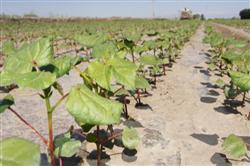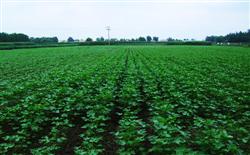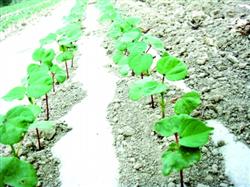Key points of Comprehensive Control of Cotton Seedling Diseases

Cotton seedling disease species, serious damage, which occurred most commonly, the most serious damage is yield blight, anthracnose and so on. The incidence rate is generally 20%~30%, and in severe cases it reaches 50%~90%. Especially in early spring, low temperature and rainy weather, weak growth of cotton seedlings, slow emergence, easy to be infected by germs, causing a large number of rotten seeds, sick seedlings and dead seedlings, even lack of seedlings and broken ridges, and even ploughing and destroying seeds, seriously affecting the high yield of cotton fields. To prevent cotton seedling diseases, the following comprehensive control measures should be taken. Cotton seedling diseases, such as anthracnose, overwinter with spores and mycelium inside and outside seeds. Before sowing, seeds must be carefully selected, rotten seeds, diseased seeds and miscellaneous seeds must be eliminated, and seeds must be exposed to sunlight for 1~2 days in sunny days to kill some of the germs carried by seeds, improve seed quality, promote seed ripening, facilitate seed germination rate, promote seedling uniformity, seedling strength and disease light. Fine soil preparation and complete cleaning of litter and rotten bolls around cotton field before soil preparation are effective measures to control anthracnose and blight. Before ploughing, apply enough base fertilizer, and the ground should be leveled and fine to facilitate seedling emergence. Cotton fields should be well drained, especially low-lying cotton fields, to achieve deep grooves and high ridges, especially in southern cotton areas, where there is more rain in spring and the groundwater level is high. Deep grooves and high ridges are conducive to drainage, reduce soil moisture, and receive disease prevention and seedling protection effects. Timely sowing late sowing is not conducive to the growth of cotton seedlings; early sowing, low temperature, low soil temperature, too slow emergence, conducive to the invasion of pathogens harm. The optimum sowing time is usually 5 cm soil temperature above 12℃, i.e. the middle of April for cotton area in Yangtze River Basin and the last ten days of April for cotton area in North China. Cotton seedling blight overwinters mainly in the form of mycelium or sclerotia in soil or on the residues of diseased plants. Pathogens in soil can live for 2~ 3 years by saplings. Colletotrichum gloeosporioides can also overwinter on the residue of diseased plants by conidia and mycelium. After cotton sowing, all can invade cotton seedlings and cause disease. If the rotation of paddy and upland is carried out, the pathogenic bacteria in the soil can be greatly reduced and eliminated, and it has a good effect on controlling the diseases such as anthracnose. For example, interplanting with wheat, rape, broad bean and other crops, wheat should be tied, rape should be old leaves, swallow beans should be topped in time, so as to facilitate ventilation and light transmission, reduce field humidity, and reduce disease occurrence. 5.1 seed dressing with 25% rice foot green temperature powder 0.5 kg mixed with 10kg semi-dry and semi-wet fine soil and plant ash, can be mixed with cotton seed 100kg, it is better to mix and sow now, can not be mixed for a long time; also can use 0.5% rice foot green water solution to dress seeds after storage for 15 days before sowing, can control blight, anthracnose and blight. 5.2 Carbendazim seed dressing with 50% carbendazim WP 1 kg, or 25% carbendazim WP 2 kg, mixed with cotton seed 100 kg, can control seedling diseases such as blight, anthracnose, cotton wilt and verticillium wilt 5.3 Soaking cotton seeds with carbendazim colloidal suspension 0.7 kg 40% carbendazim colloidal suspension, 100 kg water, 50 kg soaked cotton seeds, soaking for 14 hours, taking out a little water can be sown, control anthracnose, blight effect is good, also has a certain effect on cotton wilt, verticillium wilt. 5.4 Wuduo mixture seed dressing Wuduo mixture is composed of pentachloronitrobenzene and carbendazim. When seed dressing with 0.5 seed preparation, mix immediately or sow, can control blight, anthracnose, red rot and blight. 5.5 Seed dressing double dressing seed dressing 40% seed dressing double wettable powder is prepared according to 0.1%~0.2% of seed quantity, and can be sown after mixing, which can control blight, anthracnose and blight. 5.6 Seed coating agent is composed of carbofuran and carbendazim. Seed dressing with 0.5% seed coating agent, seed dressing can be sown, can control blight, anthracnose and blight, and can also control seedlings aphid. 5.7 802 "seed dressing cotton before sowing, with" 802 "antibacterial agent 3000 times solution, add cottonseed weight of 60% liquid medicine, while spraying while rubbing seeds, until the drug spray is finished, stand for 4~6 hours after sowing. Cotton seeds can also be submerged with 3000 times solution for 6~10 hours, and then the excess solution can be filtered out. It can prevent and control blight, anthracnose and red rot. According to the experiment, after seed dressing with "802", the number of lateral roots per plant and the dry matter weight per plant at 5-leaf stage increased by 5.85 and 4.05% respectively compared with the control. After cottonseed emergence, if it encounters low temperature and heavy rain, especially after cold wave attack, seedling disease is likely to occur epidemic. Therefore, it is necessary to timely use Boluo solution (1:2:20) or 50% carbendazim WP 800 times solution, or 20% Daojiaoqing WP 1000 times solution, or 50% Tuijunte WP 1000 times solution, or other effective pesticides for prevention and protection. kg solution is used every 667m2.
- Prev

Key points of cotton management in July
July is the month of the fastest growth and the largest growth of cotton, and it is also the month of drastic weather changes, many disasters and serious diseases and insect pests. Most cotton fields enter the flowering stage in early July, and by the end of July, 90% of the vegetative and reproductive organs of cotton plants have grown.
- Next

Control techniques of Diseases and insect pests in Cotton Seedling stage
During the transplanting period, cotton seedlings are often affected by abnormal climate, weak seedlings, inadequate cultivation measures and other factors, which slow down the growth process and reduce the yield of cotton. The causes and prevention of cotton stiff seedlings are introduced as follows: first, reason 1. Cotton seedlings.
Related
- The first cup of black tea in spring, the flavor and history of tea gardens in Kenya, Africa
- The computer can not only choose potatoes, but also grow tea rice. AI will grow winter oolong tea champion.
- It is not only the inflated tea bitten by insects, but also engraved with the four seasons tea in Beipu.
- The Oriental Beauty Tea Festival in Zhuxian County takes the stage at the weekend to experience the plus-size feast of oil tea.
- & quot; Oriental Beauty Tea & Exploration of Emei in Hsinchu, the hometown of quot;
- The new variety of strawberry "Tainong 1" dessert is the first choice with mellow aroma. Crimson gorgeous
- History of Tea in Taiwan: from Wild Inner Mountain to Export Tea Garden
- Two types of Taiwan Oriental Beauty Black Tea won the British three-Star Award for Childhood Tea Xiang Zhang Jiaqi changed from pilot to champion tea maker.
- Banana species and varieties: the planting history of Taiwan Xianren banana and dwarf banana is long, is banana disease resistant?
- Coffee planting Technology: Qianjie Coffee from Seedling to harvesting

